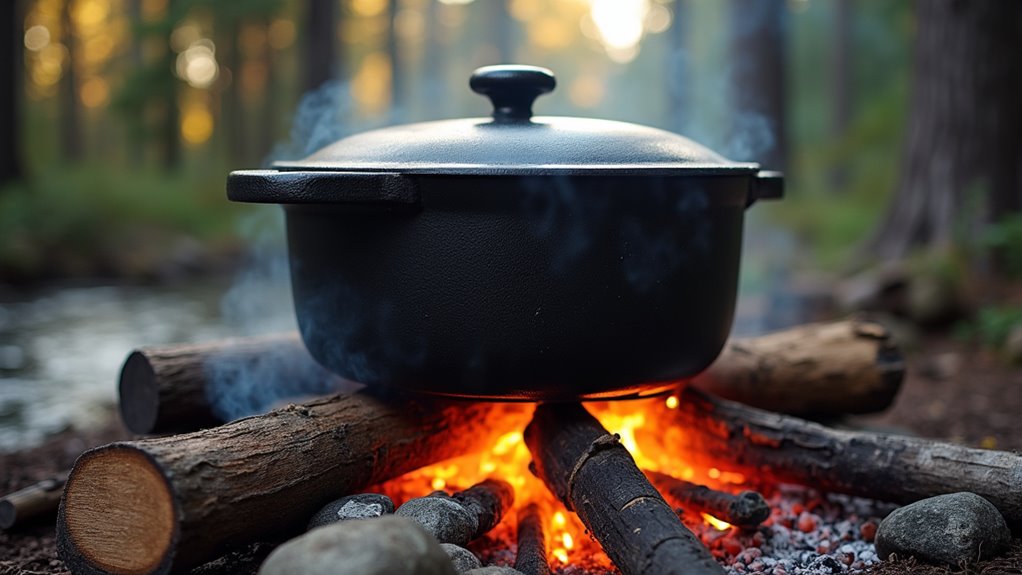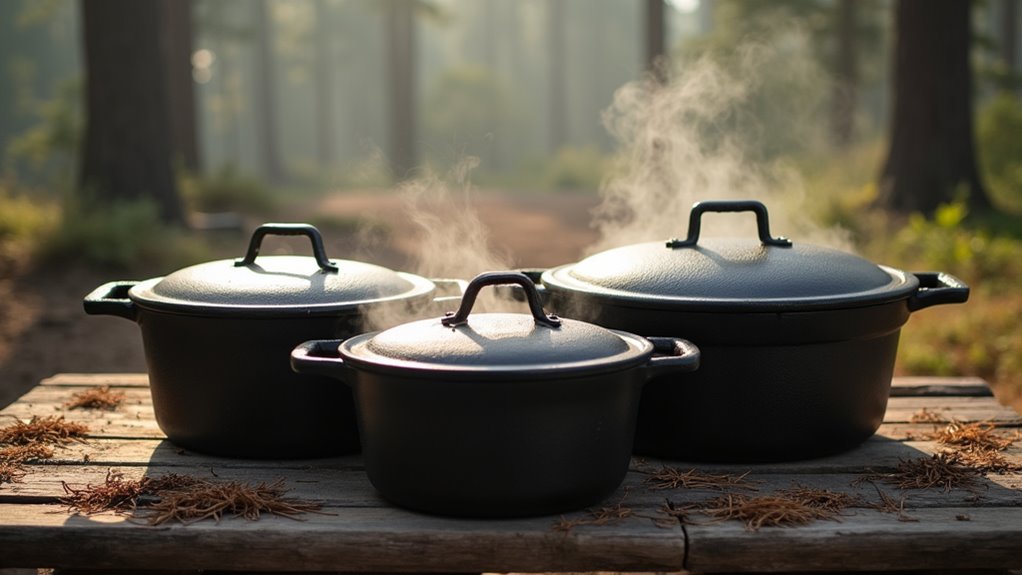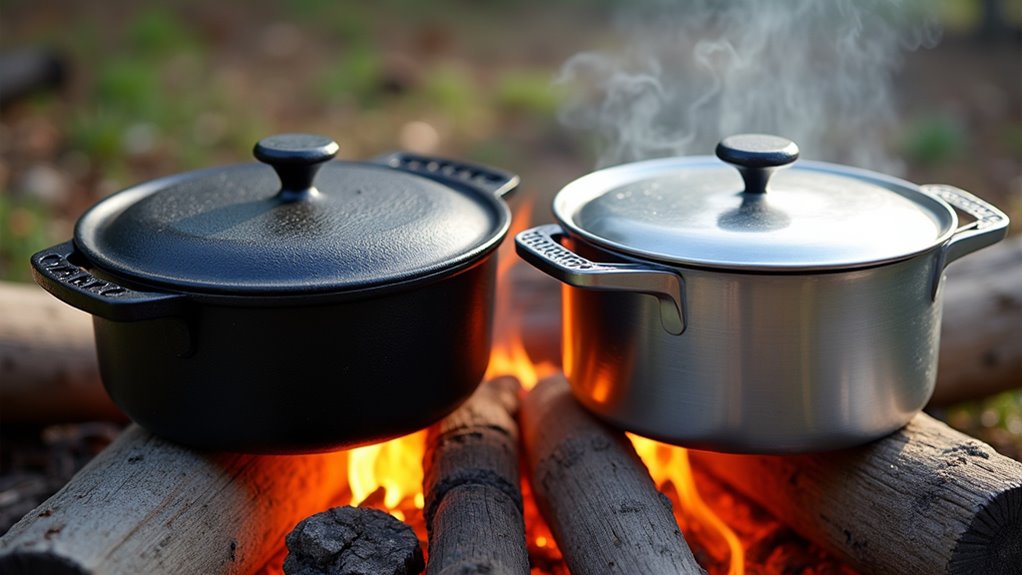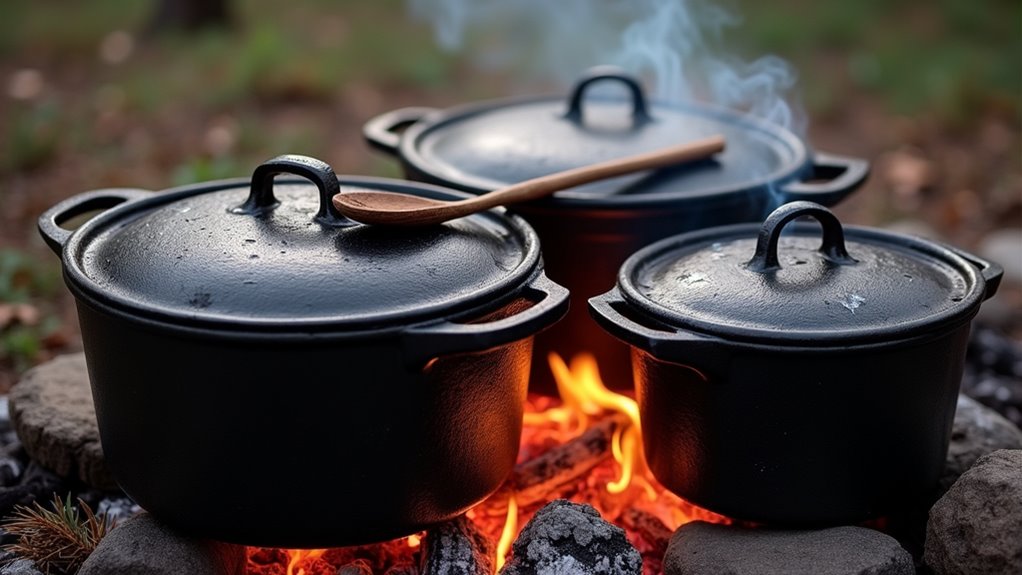Physical Address
304 North Cardinal St.
Dorchester Center, MA 02124
Physical Address
304 North Cardinal St.
Dorchester Center, MA 02124

Navigate the world of outdoor cooking with top-rated camping Dutch ovens that transform simple ingredients into mouthwatering wilderness feasts.
Ever wondered why seasoned campers swear by their Dutch ovens as if they’re guarding a secret treasure? You’ll find that these versatile cooking vessels can transform your outdoor meals from basic camping fare to gourmet wilderness cuisine. Whether you’re baking bread, simmering stews, or crafting cobbler under the stars, choosing the right Dutch oven for your camping style and budget can make all the difference. Let’s explore the top options that’ll help you master campfire cooking without breaking the bank.

When it comes to elevating your camping experience, a Dutch oven distinguishes itself as one of the most versatile and practical investments you’ll make.
You’ll discover that one pot can handle everything from baking bread to simmering stews, eliminating the need to pack multiple cooking vessels.
The thick cast iron walls distribute heat evenly and retain it longer, ensuring your meals cook consistently over the campfire. The flat raised rim on outdoor Dutch oven lids allows you to place hot coals on top for even cooking from all directions.
Cast iron’s superior heat distribution and retention creates a reliable cooking environment, turning your campfire into a precision cooking tool.
You won’t have to worry about hot spots or sudden temperature changes affecting your food. Essential camping cookware is a crucial consideration for your outdoor adventures.
Plus, you’re investing in durability that’ll last generations – these pots can withstand rough outdoor conditions and become cherished family heirlooms.
With a tight-sealing lid and efficient design, you’ll spend less time on cleanup and more time enjoying memorable meals that bring everyone together around the campfire.
Before investing in a camping Dutch oven, you’ll need to focus on several key features that determine both performance and value.
Look for bare cast iron construction with thick walls and a well-seasoned surface – this guarantees excellent heat retention and creates a natural non-stick coating. The consistent thickness provides superior durability and reliable cooking outcomes. The lid should be heavy and feature a raised rim to hold coals for even heat distribution.
For most camping situations, a 12-inch oven with three legs will serve 10-12 people efficiently. If you’re cooking for smaller groups, consider a 10-inch model. Essential gear for delicious camping meals should also be considered when selecting your Dutch oven.
Make certain your choice includes sturdy handles and a tight-fitting lid that prevents heat loss. Don’t forget to check the weight – while heavier ovens offer better durability, you’ll need to balance this against your ability to transport it to your campsite.

Several standout Dutch ovens have proven their worth in rugged outdoor conditions, offering reliable performance for campers who demand quality without breaking the bank.
The Barebones Polished Cast Iron leads the pack with its lighter construction and exceptional heat control, making it ideal for both campfire and stove cooking.
If you’re seeking a traditional option, the Guidecast Lightweight model excels in all cooking tasks while remaining portable.
For baking enthusiasts, Camp Chef’s Classic features a smart thermometer notch and convertible lid-to-skillet design.
For those willing to invest in premium quality, the Smithey Dutch Oven delivers heirloom-level durability and precision engineering. The even heat distribution ensures consistent cooking results whether you’re simmering stews or baking bread outdoors.
Each of these models offers pre-seasoned surfaces, sturdy handles, and the versatility you’ll need for diverse outdoor cooking methods.
Choosing the right Dutch oven size can make or break your camping cooking experience. You should aim to follow the basic rule of one quart per person per meal. For solo trips or couples, a 2-4 quart oven will serve you well.
If you’re cooking for a family of 4-6, opt for a 5.5-6 quart model. A 12-inch shallow model is perfect for this group size, offering 8 quarts of cooking capacity. Top Dutch Ovens Perfect for Your Camping Adventures can provide more guidance on suitable options.
Remember that bigger isn’t always better. While larger ovens offer more versatility, they’re considerably heavier and harder to transport. A 12-quart oven might seem appealing, but it can weigh over 30 pounds – not ideal if you’re moving camp frequently.
Size matters – but not always in the way you think. A massive Dutch oven can become a backpacking burden rather than a blessing.
For car camping, you can go bigger, but for sites requiring any hiking, stick to medium sizes. Consider adding an extra quart to your calculations if you want leftovers or might’ve unexpected guests.

Once you’ve determined the right size for your camping Dutch oven, you’ll face another key decision: cast iron or aluminum. Each material offers distinct advantages that’ll impact your camping experience.
If you’re backpacking or planning multi-day trips where weight matters, aluminum’s lighter design will save you considerable effort – it’s about one-third the weight of cast iron. Many campers appreciate that aluminum Dutch ovens are easier to clean since they can be washed with regular soap and water.
It’ll also heat up faster and won’t rust, making maintenance easier. However, if you’re setting up a base camp and prioritize cooking performance, cast iron’s superior heat retention and even distribution make it ideal for slow-cooking and baking. While it’s heavier and requires seasoning, it’ll deliver more consistent results.
Consider your budget too – aluminum tends to be more affordable, while cast iron’s higher price reflects its durability and premium cooking capabilities.
To keep your camp Dutch oven performing at its best, proper care and maintenance are essential after each use.
Start by scraping out food particles with a soft brush or rubber spatula, then rinse with warm water. If needed, use a small amount of mild detergent, but avoid harsh soaps that can damage the seasoning.
After cleaning, dry your Dutch oven thoroughly with a towel and apply a thin layer of cooking oil inside and out to maintain its seasoning. Remember to rotate your cast iron pot every 10-15 minutes when drying to ensure even coverage. Mastering the art of camp cooking is essential for ensuring your Dutch oven remains in top condition.
When storing, place the lid slightly ajar to allow air circulation and prevent moisture buildup. Keep paper towels inside to absorb any residual moisture.
For protection during transport, invest in a Dutch oven tote or wooden case. Store your oven in a dry place, away from play areas, and remember to re-season before your next camping trip.

Whether you’re a novice camper or seasoned outdoor chef, mastering Dutch oven cooking techniques will transform your campsite meals from basic to extraordinary. Your success depends on understanding heat management and proper food preparation methods. By controlling coal placement and monitoring temperature, you’ll achieve consistent results every time. Most baking requires approximately 21 charcoal briquettes to maintain a consistent 350°F temperature in a 10-inch Dutch oven.
Essential cooking tips can help you plan and prepare for your next camping adventure. Remember to use long-handled utensils and oven mitts when handling your Dutch oven. You can cook everything from breakfast to dessert, adapting your favorite recipes for outdoor cooking.
With practice, you’ll develop an intuitive sense of temperature control and timing.
Building on your Dutch oven expertise, a well-organized campfire kitchen becomes your command center for outdoor cooking success.
Start by selecting a flat spot away from flammable materials and considering wind direction to avoid smoke blowing into your camp. Position your setup near a water source while maintaining a safe distance from other campers. Proper camp kitchen maintenance is essential for a successful outdoor cooking experience.
Smart campsite cooking starts with location – find level ground, watch the wind, and stay close to water but away from neighbors.
Create distinct zones for food prep, cooking, and cleaning using a portable table as your workstation. Set up separate waste containers for garbage, recycling, and compost to maintain a tidy cooking space. You should aim to maximize vertical storage to keep essentials within reach and maintain an efficient workflow.
Don’t forget to establish a proper cleaning station and keep food in airtight containers to deter wildlife. Stay eco-conscious by using reusable items and environmentally friendly cleaning products.
Remember to keep a fire extinguisher nearby and always sanitize your surfaces before and after use.
Ready to elevate your camp cooking game? Whether you choose the lightweight Barebones Polished Cast Iron or the versatile Camp Chef Classic, you’ll find that a quality Dutch oven is worth every penny. Pick the size that fits your group, maintain it properly, and you’re set for years of memorable outdoor meals. Remember, you don’t need the priciest option – just one that matches your camping style and cooking needs.